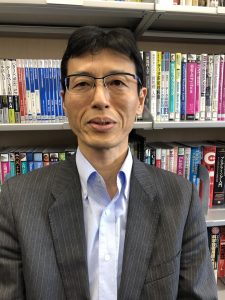

KAWAHARA, Daisuke
Professor, Doctor of Informatics
We explore information and communication technologies that support a smart and global society from the perspectives of communication engineering, information systems, and media contents. By studying communication network technology and computer technology in a balanced manner, we acquire the knowledge and skills necessary to contribute to the realization of a smart social infrastructure and the development of a global society.
I specialize in natural language processing (NLP), a research field that focuses on enabling computers to understand and generate human language. The outcomes of NLP include search engines, machine translation systems, and chatbots. You may use search engines on the web to find information, sometimes use machine translation systems to translate foreign languages, or ask questions to chatbots like ChatGPT.
Our laboratory aims to develop AI systems that can understand and use language at the same level as humans by acquiring and using linguistic and world knowledge and integrating the insights and techniques of computer science and linguistics. Recently, we have been focusing on the construction, utilization, and evaluation of large language models (LLMs), the integration of knowledge into LLMs, and the development of evaluation benchmarks. In the future, the accuracy of applications that support human linguistic activities, such as search engines and machine translation systems, is expected to improve, becoming even more convenient.
People use language effortlessly, but when it comes to handling it with computers, many challenges arise. For instance, to create a computer that understands language, we need to define “understanding,” which is very difficult. One method is to list multiple tasks that a computer should be able to do if it understands language and test how well it can solve them. Our laboratory is also trying this approach.
Recently, LLMs and generative AI have been producing useful and fluent outputs and responses. However, they also have many problems, such as generating inaccurate information, known as hallucinations, and biases. Studies on how well LLMs understand language and how to reduce hallucinations and biases are challenging, but they are interesting research topics.
One of the purposes for which people use language is communication. Natural Language Processing (NLP) aims to achieve this on computers, making it a part of the information and communication field. Furthermore, the progress in this research is supported by the continuously advancing computers and the Internet, relying on various research and developments in electrical and electronic engineering, as well as information and communication technologies.
“Department of Computer Science and Engineering” and “Department of Communications and Computer Engineering” are considered sibling departments, as they are integrated into a single department in the graduate school. While their research themes overlap to some extent, the Department of Communications and Computer Engineering, as its name suggests, focuses primarily on communication. This includes networks such as the Internet, broadcasting, wireless, and optical communication technologies, along with the handling of contents flowing through these networks. Since everything on a network falls within its purview, the range of applications it covers is quite extensive. Students interested in the Department of Communications and Computer Engineering should look into the specific laboratories in the department. By the way, generative AI might be useful for this purpose, but it is important to critically verify the accuracy of responses.